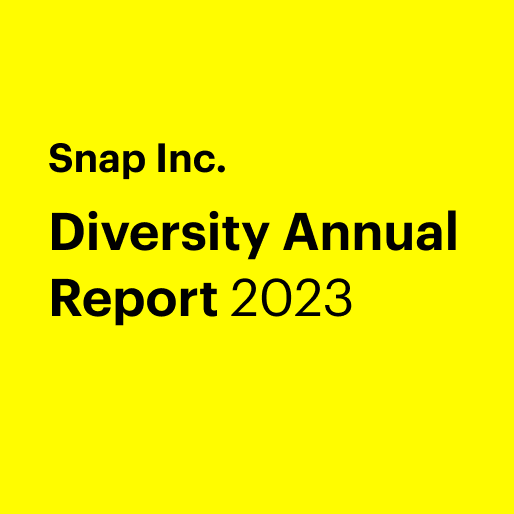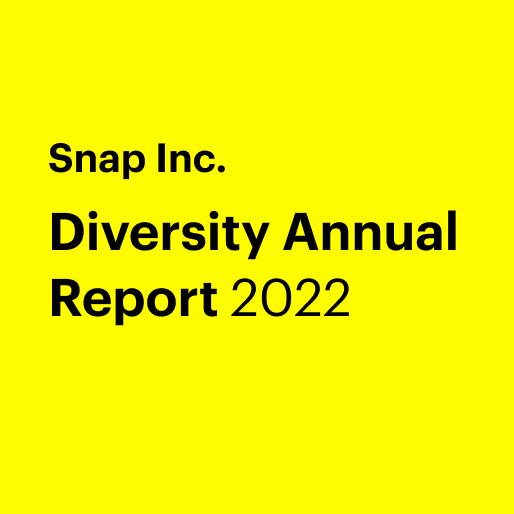Resources

2024 Diversity Annual Report
Millions of people from all walks of life use Snapchat every day to communicate with friends and family. It’s important for us to bring the same diversity of cultures, backgrounds, and perspectives together at Snap Inc.
Learn more about diversity at Snap
See what else we're up to
Data Terms
Below are some key terms and their definitions used in this report.
First-Generation College Graduate
A person who is the first in their family to complete a 3- or 4-year college/university. We based this on the level of education a person received compared with the highest level of education their parents/guardians received.
Gender
All gender data are global, unless stated otherwise. We use responses from the DEI Self-ID Survey supplemented with Regulatory Data in cases where team members did not complete the DEI Self-ID Survey.
Historical Data
Historical data within this report may reflect changes when compared to previous reports, as we allow our team members to update their self-ID data 365 days a year. Snap's 2021 report reflects 2020 self-ID data through 12/31/2020.
Hispanic/Latinx
In this report, we have chosen to use the term Hispanic/Latinx to refer to both communities with Spanish-speaking origins (Hispanic) and anyone of Latin American origin including groups that may not be Hispanic (Latinx). This term is also the most gender inclusive, though we recognize another option is Latino/a/e.
Military Organization
Any military organization regardless of geographic location.
Multiple Races
A person who generally identifies with more than one race and/or ethnicity. We ask team members who identified as “Multiple Races” to select which races apply.
Non-Binary
An umbrella term to describe the gender identity of someone who does not identify exclusively as a man or a woman. Nonbinary people may identify as being both a man and a woman, somewhere in between, or as falling completely outside these categories. Non-binary can also be used as an umbrella term encompassing identities such as agender, bigender, genderqueer or gender-fluid.
Non-Tech
Defined at the individual team member level based on the specific characteristics of their job and includes team members across all organizations that do not fall into the Tech category as defined here. For example, Non-Tech roles include executive assistants in the engineering organization.
People Managers
Team members who have one or more direct reports. Direct reports include full-time and part-time employees, but do not include contingent workers.
Race/Ethnicity
All race/ethnicity data are US-only, unless stated otherwise. We use responses from the DEI Self-ID Survey supplemented with Regulatory Data in cases where team members did not complete the DEI Self-ID Survey. On our DEI Self-ID Survey we ask team members which race/ethnicity they primarily identify with. For example, if a person usually selects “Multiple Races” but primarily identifies with one group over another (e.g., Black or Asian), they can select that specific group. We moved to this new methodology 2 years ago to allow a more accurate reflection of our team member’s lived experience (someone who technically identifies with multiple races but presents as Black may face the same systemic racism as someone who identifies solely as Black).
Regulatory Data
Data collected for the purpose of government reporting.
Tech
Defined at the individual team member level based on the specific characteristic of their job and includes team members across all organizations that manage technical products or processes, develop systems or software, work on the development of products or tools, or require and utilize a specialized engineering background in their role. Tech roles include software engineers, product designers, and research scientists, among other job roles.
Undeclared
Team members for whom we do not have a record of gender.
Underrepresented U.S. racial groups
While we use the term underrepresentation in this report, we recognize that its meaning changes across different locations. In this report, we define “underrepresented U.S. racial groups” as Black, Hispanic/Latinx, Indigenous, Middle Eastern/North African/Arab and Multiple Races.
Our Data
Our 2025 Goals




